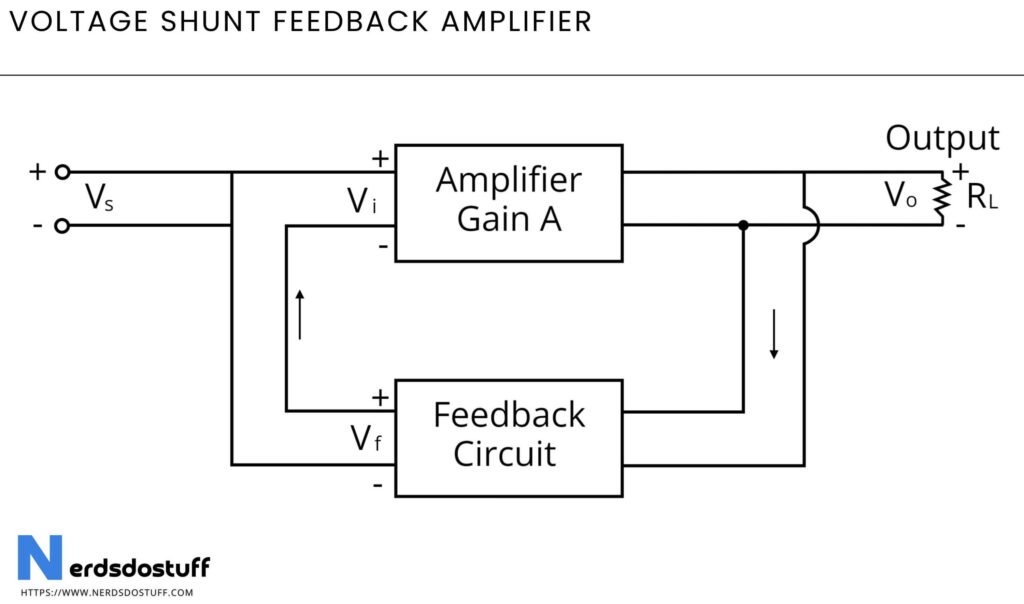What is Voltage Shunt Feedback Amplifier ?
A voltage shunt feedback amplifier is an electronic circuit configuration in which the feedback signal is derived from the output voltage and fed back into the input in parallel with the input signal. In this design, the feedback voltage is applied in a manner that opposes the input signal, typically being in phase opposition. This shunt feedback mechanism helps regulate and stabilize key parameters such as gain, input impedance, and bandwidth in the amplifier. By adjusting the level of feedback, designers can control and optimize performance characteristics while improving linearity and reducing distortion. Voltage shunt feedback amplifiers find applications in audio systems, instrumentation, and other electronic circuits where precise control of signal parameters and high fidelity are essential for reliable and efficient operation.
Why Voltage Shunt Feedback Amplifier is used ?
Voltage shunt feedback amplifiers are widely employed in electronic circuits for their ability to provide controlled amplification while maintaining stability and minimizing distortion. In a voltage shunt feedback amplifier, the feedback signal is connected in parallel to the input, offering unique advantages in terms of performance and flexibility.
One primary benefit of voltage shunt feedback amplifiers is their impact on input impedance. By applying the feedback in parallel with the input, these amplifiers can significantly reduce the input impedance seen by the source. This is particularly useful in scenarios where matching the input impedance is critical, enhancing the versatility of the amplifier in various applications, including communication systems and instrumentation.
Voltage Shunt Feedback Amplifier Circuit Diagram

Working of Voltage Shunt Feedback Amplifier
- Input Signal and Parallel Feedback: The process begins with the application of an input voltage signal to the amplifier. Simultaneously, a portion of the output voltage is taken and fed back in parallel to the input signal through a feedback network.
- Amplification Stage: The input signal is then amplified in the main amplification stage of the circuit, typically using active components like transistors or operational amplifiers. The amplification process increases the strength of the input signal.
- Parallel Feedback Adjustment: The feedback network connected in parallel influences the input signal by providing an additional path for current to flow. This alters the input impedance of the amplifier, allowing for controlled and predictable changes to the input signal.
- Adjustment of Input Signal: The parallel feedback affects the input signal by altering the impedance and, consequently, the input voltage. This modification contributes to the control of the overall amplification and influences parameters such as gain and linearity.
- Controlled Output: As a result of the parallel feedback, the output voltage is more controlled and regulated. The shunt configuration helps in maintaining a stable output by compensating for variations in the input signal and mitigating nonlinearities in the amplification process.
- Improved Linearity and Reduced Distortion: The feedback mechanism in a voltage shunt feedback amplifier contributes to improved linearity, minimizing harmonic distortion in the output signal. This makes the amplifier suitable for applications where faithful signal reproduction is critical.
- Enhanced Stability: The shunt feedback design helps enhance the stability of the amplifier by providing a level of control over the input impedance. This makes the amplifier less sensitive to changes in external conditions or variations in individual component characteristics.
Applications of Voltage Shunt Feedback Amplifier
- Audio Amplification: Voltage shunt feedback amplifiers are employed in audio systems, including amplifiers for home audio and professional sound systems. The shunt configuration helps control the input impedance and improve linearity, contributing to high-quality audio reproduction with reduced distortion.
- Instrumentation Amplifiers: In precision measurement and instrumentation applications, voltage shunt feedback amplifiers play a crucial role. Their ability to control input impedance and enhance stability makes them suitable for use in sensitive measurement instruments and sensor interfaces.
- Operational Amplifiers (Op-Amps): Voltage shunt feedback is commonly utilized in operational amplifier circuits for various applications, such as signal conditioning and filtering. This configuration allows for precise control over gain, input impedance, and other parameters critical in analog circuit design.
- Communication Systems: Voltage shunt feedback amplifiers are applied in communication systems, especially in RF (Radio Frequency) and microwave amplifiers. The controlled input impedance and improved stability contribute to maintaining signal integrity and ensuring reliable communication in wireless and radio frequency applications.
- Biomedical Instruments: In biomedical applications, voltage shunt feedback amplifiers are used in devices such as medical imaging equipment and biosignal amplifiers. The controlled input impedance and stability are crucial for accurate signal processing in medical diagnostics and research.
- Control Systems: Voltage shunt feedback amplifiers find applications in control systems, where stability and precise control over the input impedance are essential. They are employed in feedback loops to regulate and control dynamic systems, contributing to the stability and reliability of the control process.




